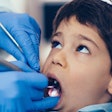
Previous research has indicated a link between higher levels of tooth decay and children who are abused or neglected. But if a child sees a physician, not a dentist, can the physician recognize the oral health signs that might suggest neglect is taking place?
Many children in the U.K. do not have a dental home, so these at-risk children may be seeing a general physician before they see a dentist. Researchers surveyed general practitioners to find out if these healthcare professionals could spot dental neglect as a marker of child neglect. Their results were published in the British Dental Journal (May 10, 2018).
"This study highlights that [general practitioners] lack training in formerly identifying dental pathology and are unaware that dental neglect could be a marker for potential wider child neglect," stated lead author Dr. Sascha Colgan in a press release accompanying the study.
Dr. Colgan is a general practitioner and visiting academic in the medical education academic unit at the University of Southampton Faculty of Medicine in the U.K.
Training and communication
One in 10 children in the U.K. have been or are being abused, and one to two of these children die each week, according to the study authors. While dental care is free to patients in the U.K., a general practitioner is often the healthcare professional children see first. Research has shown a link between dental neglect and potential child abuse, so the researchers wanted to see if U.K. physicians had the training to identify dental neglect, which may suggest child neglect.
Dr. Colgan and colleagues sent a survey to all 106 National Health Service general practitioners on the Isle of Wight in the U.K. Children younger than age 15 make up almost 15% of the total island population, they noted.
The survey included questions about the level of awareness and perceptions of these physicians on the importance of dental healthcare in identifying dental neglect and child neglect. They were also asked about the level of training they had received to identify dental pathology. Of the 106 physicians, 55 (52%) completed the survey.
The majority of general practitioners had never been in communication with a dentist, the researchers found. Only half of these doctors knew the location of their local dentist and less than 10% of respondents had ever communicated with a dentist about a patient.
The main reasons physicians listed for not examining a patient's mouth and teeth are listed in the table below.
| Top reasons physicians gave for not examining a patient's mouth and teeth | |
| Reason | Percentage of respondents |
| Lack of time | 36% |
| Lack of dental training | 34% |
| Did not want to upset the patient's feelings | 9% |
| Impediment to doctor/patient relationship | 7% |
A majority of the physicians replied that they would contact the child's parents if they noticed possible abuse/neglect. About a third would advise the child's dentist, and only 8% would call social services.
In addition, half the physicians responded that childhood immunizations were more important than children having a dental home, the researchers reported.
Addressing needs
The authors noted this was the first such survey on this topic, but it was limited by the response rate of 52%. A survey that included a wider geographic range may have different results, they added.
They concluded that physicians' lack of dental training and recognition of the importance of oral health may impair their ability to recognize both dental and child neglect.
"We know that [general practitioners] are not dentists and already have many responsibilities," Dr. Colgan stated. "Ultimately, public health policy must be implemented to address the need for greater awareness and investment in improving the prioritization of universal free access to dentistry."



















